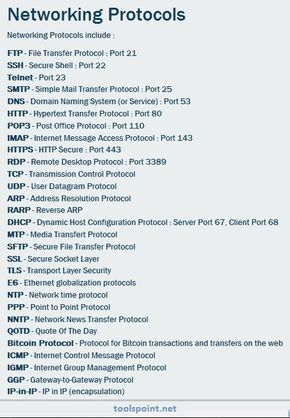Learning about networking protocols, and their importance and uses in the communications between two computers across some sort of network media, is at the center of many IT and cybersecurity certifications. The goal of this article is to provide a list of networking protocols that you need to know for your exam and for a future career in IT, networking, or cybersecurity..
Networking protocols are a crucial component of the modern Internet. They are responsible for ensuring that data can be sent between different devices and networks in a reliable and efficient manner. One of the most widely used networking protocol stacks is the TCP/IP protocol stack, which is used by most of the devices that are connected to the Internet today.
At the heart of the TCP/IP protocol stack are two main protocols: the Transmission Control Protocol (TCP) and the Internet Protocol (IP). The TCP protocol is responsible for breaking data down into small packets that can be sent across the network, and then reassembling those packets into the original data at the receiving end. The IP protocol, on the other hand, is responsible for routing those packets between different devices and networks. Together, TCP and IP form the backbone of the modern Internet, and understanding how they work is essential for anyone interested in cybersecurity or network engineering.
Here are a list of other networking protocols you will need to learn for many IT and cybersecurity certification exams.
FTP – File Transfer Protocol : Port 21
SSH – Secure Shell : Port 22
Telnet – Port 23
SMTP – Simple Mail Transfer Protocol : Port 25
DNS – Domain Naming System (or Service) : Port 53
HTTP – Hypertext Transfer Protocol : Port 80
POP3 – Post Office Protocol : Port 110
IMAP – Internet Message Access Protocol : Port 143
HTTPS – HTTP Secure : Port 443
RDP – Remote Desktop Protocol : Port 3389
TCP – Transmission Control Protocol
UDP – User Datagram Protocol
ARP – Address Resolution Protocol
RARP – Reverse ARP
DHCP – Dynamic Host Configuration Protocol : Server Port 67, Client Port 68
MTP – Media Transfer Protocol
SFTP – Secure File Transfer Protocol
SSL – Secure Socket Layer
TLS – Transport Layer Security
E6 – Ethernet globalization protocols
NTP – Network time protocol
PPP – Point to Point Protocol
NNTP – Network News Transfer Protocol
QOTD – Quote Of The Day
Bitcoin Protocol – Protocol for Bitcoin transactions and transfers on the web
ICMP – Internet Control Message Protocol
IGMP – Internet Group Management Protocol
GGP – Gateway-to-Gateway Protocol
IP-in-IP – IP in IP (encapsulation)
Share
APR





About the Author:
I am a cybersecurity and IT instructor, cybersecurity analyst, pen-tester, trainer, and speaker. I am an owner of the WyzCo Group Inc. In addition to consulting on security products and services, I also conduct security audits, compliance audits, vulnerability assessments and penetration tests. I also teach Cybersecurity Awareness Training classes. I work as an information technology and cybersecurity instructor for several training and certification organizations. I have worked in corporate, military, government, and workforce development training environments I am a frequent speaker at professional conferences such as the Minnesota Bloggers Conference, Secure360 Security Conference in 2016, 2017, 2018, 2019, the (ISC)2 World Congress 2016, and the ISSA International Conference 2017, and many local community organizations, including Chambers of Commerce, SCORE, and several school districts. I have been blogging on cybersecurity since 2006 at http://wyzguyscybersecurity.com